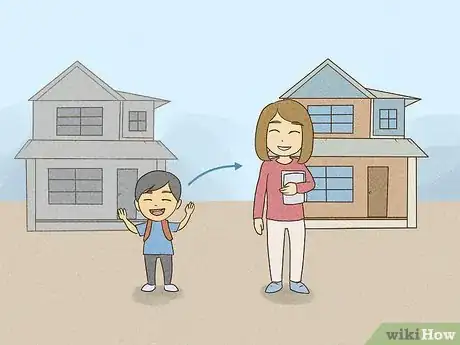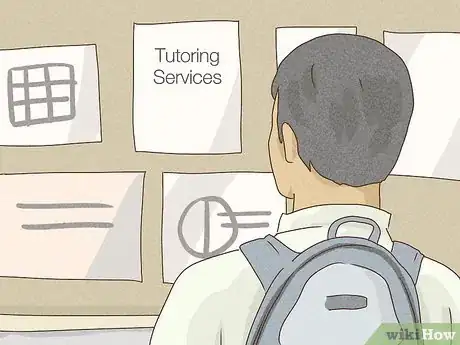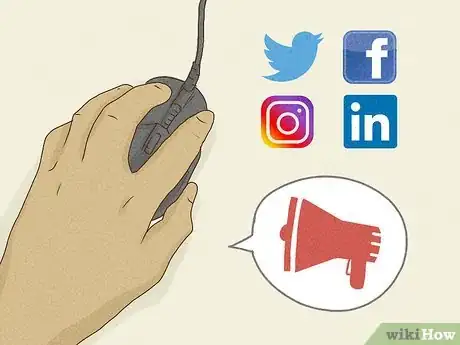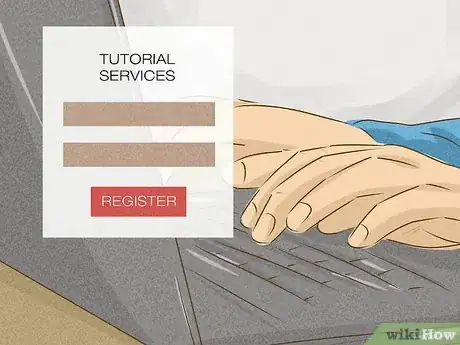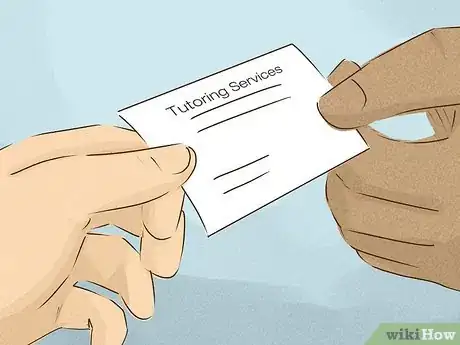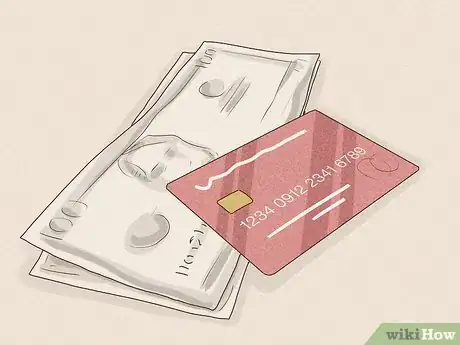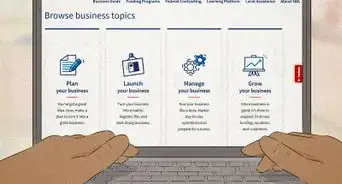This article was co-authored by Emily Listmann, MA. Emily Listmann is a private tutor in San Carlos, California. She has worked as a Social Studies Teacher, Curriculum Coordinator, and an SAT Prep Teacher. She received her MA in Education from the Stanford Graduate School of Education in 2014.
wikiHow marks an article as reader-approved once it receives enough positive feedback. This article received 16 testimonials and 90% of readers who voted found it helpful, earning it our reader-approved status.
This article has been viewed 464,672 times.
You can experience the joy of making a difference by becoming a tutor. Most tutors help students with their homework or prepare for exams, though some may create their own curriculum to teach to a student. Either way, you'll be part of helping somebody grow and learn and become who they are meant to be. You will also put your skills and expertise to good use. With a little preparation, experience, and advertising, you'll be able to start tutoring students in subjects that you love in no time!
Steps
Building Your Knowledge and Skills
-
1Determine which age or grade level/range you want to tutor. Think about what age of students you enjoy working with. Perhaps you love teaching young children, or maybe you enjoy assisting young adults with the learning process. Figuring out what age you want to teach is the first step in starting to expand your tutoring business because that will be your target audience.
-
2Choose the subjects you want to tutor. Think about in which subjects you feel you have the most skills, qualifications, and comfort level teaching to others. Consider which classes you got the best grades in or a subject related to your major in college if you have trouble deciding on a subject to tutor.[1]
- You should have at least some formal education in the subject you intend to tutor – the level depends on what kind of tutoring you do. You may only need a bachelor's degree to tutor in some situations, while others might require a more advanced degree in the field.
Advertisement -
3Understand the curriculum. Make sure you know and understand the subject or exam the student needs help with so you can maximize the effectiveness of the tutoring sessions. This may require reviewing old class notes, doing some refresher research on the Internet, or rereading an old textbook. Make some general topic outlines that you can refer to easily if you need help remembering something during a tutoring session.
- For certain classes that require structure for something like a national exam, make sure you are completely comfortable with the required syllabus.
-
4Solidify your teaching methods. Create engaging lessons using PowerPoint presentations, fun projects, or interactive activities. Make learning and studies fun by adding educational games, activities, and stories. This will make students focus more and actually enjoy their studies.
- Compliment the student on their strengths and help them see their growth.
- If a student is struggling, ask them what they can do to find a solution, rather than showing them how to do the problem yourself. This will allow them to learn how to solve diverse problems on their own.
-
5Listen to your students. A good tutor knows how to listen to their students and respond to their specific needs. This kind of attention to detail will help you retain existing clients. Tailor your lessons to each student – targeting their specific weaknesses and areas that need improvement.[2]
- For example, if a student seems to already have a good understanding of part of a topic that you intended to cover, feel free to skim through that topic instead of going as in-depth as you had planned and move on to other parts of the lesson. This way, you can focus on the aspects that the student needs the most help with to maximize the benefit for them.
- Make your lessons interesting and interactive for repeat customers. In a good lesson, the students will do much of the work – you will simply guide them through the process.
-
6Get a tutoring certification if possible. It helps to attain recognition of your qualifications by being actively involved in the knowledge or discipline you are representing, by degree or other official documentation, or by both. Many non-profit organizations look to fill volunteer tutoring positions (and sometimes will offer tutor training for free or at a low cost) which can help you gain experience as a tutor.[3]
- For example, the National Tutoring Association has a program that allow you to become an NTA-certified tutor.
- For the NTA certification, you must maintain membership in the organization, complete a certification application, submit proof of previous tutoring experience, complete a background check, and pay the required fees (about $25 USD). Then you'll be a certified tutor once the application has been processed.
Choosing a Tutoring Location
-
1Go to the student's home if they request this. In many cases, the parents or students may request that you come to their home for tutoring sessions. If they live a reasonable distance from you, this can work well. If they live far away, however, you may want to charge extra for gas money or ask that they meet you at a different location.[4]
-
2Tutor students in your home if you have the space and privacy. Sometimes, the parents or students may expect you to provide a location for tutoring. You can invite them to come to your home for convenience and to save yourself the commute. However, you will need to create a designated tutoring area and keep the space tidy. Also, if the student's parents are late to pick them up, you may have to entertain them.[5]
-
3Work in a public location if you don't want to tutor in your home. If you aren't comfortable or don't have the space to bring students to your home, you can tutor them in a public location like a library or cafe. However, these locations could be crowded or noisy.
Finding Students to Tutor
-
1Talk to teachers you know. Contact teachers and school counselors at local schools, especially those that teach the subject you are planning to tutor in. Ask them if they can tell students who currently need help about your services.[6]
- It helps to discuss this with former teachers of yours, so that they already know you are a good student and will make a good tutor.
-
2Advertise in your community. Try to post advertisements for your tutoring services in places that parents will see them. Consider posting your ads on bulletin boards at local schools, the public library, daycare centers, or even recreational places where kids often hang out.
- You can even submit an advertisement to your local newspaper – the print version or the online one.
- Make sure that you always get permission from the property owner before posting an advertisement.
-
3Advertise online. There are many ways to advertise your tutoring skills online. You can create your own website – like an online résumé you can refer potential clients to. You can post on social media about your availability as a tutor. Or you can post advertisements on various website platforms to garner more interest in your budding business.
- Consider advertising on Facebook, Twitter, LinkedIn, Pinterest, or Bing.
- But be careful if you choose to advertise on Craigslist. The website is a great way to connect with local people, but it is notorious for scams. If you find a potential client from Craigslist, make sure that you meet in public for the first few meetings.
-
4Register for online tutoring directories. Many parents or students looking for a tutor will do an online search. Registering for online directories, like care.com or wyzant, can direct people looking for a tutor right to you. These sites are usually free, and you need only provide your basic information, education, experience, and skills.
-
5Ask for referrals. When you get a tutoring client, ask them to recommend you to their classmates, friends, and family after you've spent a few weeks working together. Word of mouth recommendations are a great way to increase your client list when you first start tutoring.
- Speak with your friends, parents, or siblings about your tutoring services, and offer a discount for friends they refer to you.
- You might even consider volunteering to tutor for a little while so that your acquaintances can test you out and help you build a reputation.
Making Money as a Tutor
-
1Start working for a tutoring company. If you are nervous about being able to find your own clients, you may want to consider working at a professional tutoring company at first. There are plenty of online and in-person tutoring companies that will employ tutors and pay them.[7]
- This can also be a great way to gain some tutoring experience with a reputable company. This will look good on your résumé if you try to branch out on your own later.
- Of course, the company will take part of the profit from your tutoring sessions, so you'll probably make less money per hour going this route.
-
2Identify the going rate. In order to be taken seriously and viewed as a professional, you should charge a competitive price for your services. Charging too little or too much will make you seem outside of the competitive pool, and therefore hinder your ability to find work.[8]
- Depending on your levels of experience and education, a pretty standard going rate for in-person tutoring is $25 to $85 per hour. If you are a high school student, you'll probably need to charge on the lower end of that spectrum. If you are highly qualified (with a master's degree, for example), you could charge at the upper end of the spectrum, possibly even more.
- Ask other tutors you know how much they charge for their services.
- Do an online search to gather information about how much other tutors in your area charge.
-
3Sign up for online payment options. If you go into business for yourself, you should consider opening an online payment account to make it easy for your clients to pay you in whatever way is most convenient for them. Being able to offer credit card acceptance could make the difference between getting a client or not. There are several options for this, including PayPal and Venmo.
- Cash can be such a hassle for parents to remember for every session. If you have a PayPal option, this might make things much easier for the parents. This often translates to repeat customers.
-
4Insist on payment after each tutoring session. Be sure that your clients stay up-to-date on their payments. You should get paid for each session at the beginning or end of that session. If a student (or their parents) don't pay you for a session, you should not give them another session until the balance is paid.
- It can be all too easy for people to get behind and then it could turn into money you'll never receive for services you already supplied.
- You can consider creating payment invoices for each lesson to help the students/parents stay on top of the financial end of your arrangement.
References
- ↑ https://www.indeed.com/career-advice/career-development/what-does-a-tutor-do
- ↑ https://www.potsdam.edu/academics/resources/student-success-center/trio/tutoring/10-golden-rules-being-good-tutor
- ↑ https://www.indeed.com/career-advice/career-development/what-does-a-tutor-do
- ↑ https://www.indeed.com/career-advice/career-development/what-does-a-tutor-do
- ↑ https://www.indeed.com/career-advice/career-development/what-does-a-tutor-do
- ↑ https://www.edutopia.org/blog/what-makes-a-successful-tutor-seth-linden
- ↑ https://www.edutopia.org/blog/what-makes-a-successful-tutor-seth-linden
- ↑ https://www.indeed.com/career-advice/career-development/what-does-a-tutor-do
Expert Q&A
Did you know you can get expert answers for this article?
Unlock expert answers by supporting wikiHow
-
QuestionHow knowledgeable do you have to be in the given subject? I know this is a somewhat obvious question and I have tutored GCSE students before in maths with good results.
 Emily Listmann, MAEmily Listmann is a private tutor in San Carlos, California. She has worked as a Social Studies Teacher, Curriculum Coordinator, and an SAT Prep Teacher. She received her MA in Education from the Stanford Graduate School of Education in 2014.
Emily Listmann, MAEmily Listmann is a private tutor in San Carlos, California. She has worked as a Social Studies Teacher, Curriculum Coordinator, and an SAT Prep Teacher. She received her MA in Education from the Stanford Graduate School of Education in 2014.
Test Prep Tutor This depends on the subject and your students’ expectations. If there is a large gap in ability between yourself and your student, you may be able to get away with tutoring a subject you are not an expert in. For example, I am not particularly amazing at math but I would feel comfortable tutoring a 4th grader in arithmetic. However, I would not feel comfortable teaching a college student calculus. Just be honest with yourself and your students about how well versed you are in a given subject and let them decide whether they feel you are an appropriately educated tutor.
This depends on the subject and your students’ expectations. If there is a large gap in ability between yourself and your student, you may be able to get away with tutoring a subject you are not an expert in. For example, I am not particularly amazing at math but I would feel comfortable tutoring a 4th grader in arithmetic. However, I would not feel comfortable teaching a college student calculus. Just be honest with yourself and your students about how well versed you are in a given subject and let them decide whether they feel you are an appropriately educated tutor. -
QuestionCan I be a tutor of a preschooler?
 Community AnswerYes, you can. Ask the parent if they are struggling with a certain topic, such as switching letters in the alphabet.
Community AnswerYes, you can. Ask the parent if they are struggling with a certain topic, such as switching letters in the alphabet. -
QuestionCan I became a tutor if I'm only 15 years old?
 Community AnswerYes, because you don't have to be certified. Try tutoring students anywhere from 4th grade to 7th grade.
Community AnswerYes, because you don't have to be certified. Try tutoring students anywhere from 4th grade to 7th grade.
Warnings
- Avoid any situation that will put your students or you in any danger. Meet in a public place or at the student's house, but only if a parent will also be home.⧼thumbs_response⧽
About This Article
To become a tutor, start by identifying the subjects and grade levels you feel comfortable teaching. If you need to, brush up on those subjects so you'll be fully prepared to help your students. Next, advertise your services in your community, online, and at local schools, and be sure to include contact information so you can answer inquiries and schedule appointments with your prospects! Try to be flexible about where the tutoring will take place, since some parents may want you to come to their home. For tips on getting a certification in tutoring, read on!







